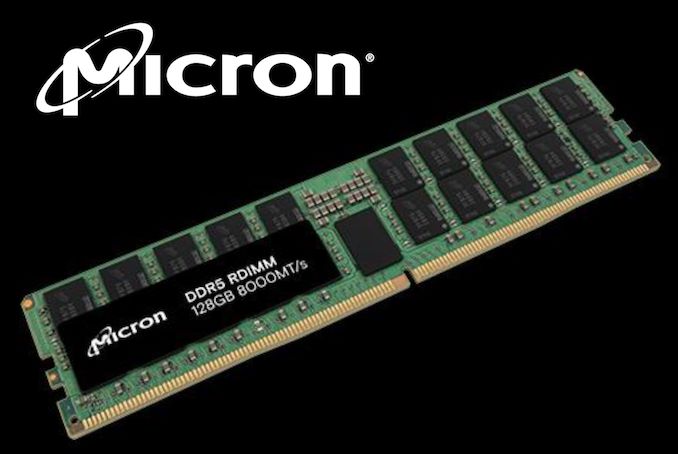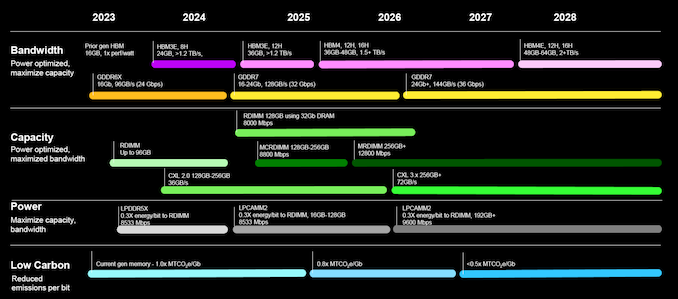Micron Introduces 128 GB DDR5-8000 RDIMMs with Monolithic 32 Gb Die
by Ganesh T S on November 9, 2023 9:00 AM EST
The path to high-capacity RDIMMs for servers has primarily been through 3D stacking (3DS) of DRAM dies using Through-Silicon Vias (TSVs). However, this has presented significant challenges in packaging (driving up the cost), and has also not been efficient in terms of energy consumption. The demand for large memory capacity RDIMMs is being primarily driven by the sudden emergence of large-language models (LLMs) for generative AI and increasing CPU core counts. Both of these require significant amount of DRAM to keep pace with performance requirements. Keeping these in mind, Micron is introducing 128 GB DDR5 RDIMMs capable of operating at up to 8000 MT/s today, with mass-production slated for 2024.
Micron has recently started fabricating 32 Gb monolithic DDR5 dies using its proven and mature 1β technology. The new dies have a 45%+ increase in bit density, and are capable of reaching up to 8000 MT/s while also operating with much more aggressive timing latencies compared to the standard JEDEC specs. The company is claiming that it improves energy efficiency by as much as 24% compared to the competition's 3DS TSV offerings, and the faster operation can also help in faster AI training times. Avoiding 3DS TSV allows Micron to optimize the data input buffers and critical I/O circuits better, while also reducing the pin capacitance on the data lines. These contribute to the reduced power and improved speeds.
Micron has been doubling its monolithic die density every 3 years or so, thanks to advancements in CMOS process as well as improvements in array efficiency. The company sees a clear path to 48 Gb and 64 Gb monolithic dies in the future with continued technological progress. Micron is also claiming that its 1β node has reached mass production ahead of the competition, and that it has had the fastest yield maturity in the company's history. Dual-die packages and tall form-factor (TFF) modules using 1β DRAM are expected to enable 1TB modules in the near future.
Along with the announcement of the 128 GB RDIMMs using 1β technology, the company also laid out its roadmap for upcoming products. HDM and GDDR7 are expected to dominate bandwidth-hungry applications, while RDIMMs, MCRDIMMs, and CXL solutions are in the pipeline for systems requiring massive capacity. LPDDR5X, and LPCAMM2 solutions going up to 192 GB are expected to make an appearance in power-sensitive systems as early as 2026.












15 Comments
View All Comments
knightspawn1138 - Thursday, November 9, 2023 - link
While reading the article, it doesn't feel right to refer to multiple die as dice instead of dies. Is this a typo, or is there some new technical terminology where multiple DRAM dies are referred to as dice? AFAIK, dice refer to small multi-sided objects used in D&D campaigns or Vegas trips to the craps table.nandnandnand - Thursday, November 9, 2023 - link
I hear about "monolithic dies" all the time, never "dice".DougMcC - Thursday, November 9, 2023 - link
en.wikipedia.org/wiki/Die_(integrated_circuit) suggests that dice, dies and die are all accepted plurals but by listing dice first suggests it may be the most commonly accepted plural.Sahrin - Friday, November 10, 2023 - link
Dice was and has always been the correct plural for die, lazy people got dies included because they couldn’t be bothered to learn another English grammar rule.Rοb - Friday, November 10, 2023 - link
The plural form of 'die' (a type of tool) is dies.The plural form of 'die' (a 6-sided object used in games) is dice.
Dice is also singular, so those that argue (that in this usage) the plural of die is dice should have simply used dice in the first place.
Tunnah - Sunday, November 12, 2023 - link
Why did you type that out like you'd c&p'ed it from somewhere legit when it's something you pulled out your arse ?die (plural dice or (nonstandard) dies)
nandnandnand - Thursday, November 9, 2023 - link
That's a fast RDIMM.64 GB UDIMMs incoming?
niconiconi - Thursday, November 9, 2023 - link
The future of ECC UDIMM looks bleak. The user base was already small enough in the DDR4 era, but still with some desktop and workstation users. Now the user base has become even smaller as both Intel and AMD workstations moved to RDIMMs, so only industrial PCs and some AMD desktops still use them, making them a low-priority product. This explains why there are many fast RDIMMs for sale today but not many UDIMMs, and why it took ~6 months for AMD to properly support ECC in AGESA firmware for Zen 4 desktops.Thus it's reasonable to expect UDIMM to move at a slower pace than RDIMM... Fast UDIMMs will probably only become common after JEDEC-spec fast RDIMMs entered use in servers - since today's Intel and AMD CPUs are not rated faster than 4800 MT/s, it will take a while.
brucethemoose - Friday, November 10, 2023 - link
They might be CAMM only since they are so fast.HotdogNoire - Thursday, November 9, 2023 - link
Huh. I didn't know that Micron manufactured abnormaly sized dice, good to know.